Blue mussels also detected in Anda, Bolinao
THE presence of blue mussels is not limited to Dagupan City after all.
Following the discovery of the blue mussel species in the waters of Dagupan City a month ago, more of this kind was detected in the coastal towns of Anda and Boinao.
Dr. Westly Rosario, chief of the National Integrated Fisheries Technology and Development Center (NIFTDC), said the initial discovery of blue mussels (mytilus edulis) in Sitio Tocok of Barangay Lucao in the city surprised him and other aquaculture scientists since the specie found mostly only in cold regions like North America, Europe and Scotland.
Prior to the discovery, the country has only two types of mussels: the brown and the green-lipped.
“When I gave the sample to the United States for DNA (deoxyribonucleic acid) analysis and profiling, the scientists were surprised to know that blue mussels grew in a tropical country like the Philippines,” Rosario said during the KBP Forum held at the Philippine Information Agency office on Thursday.
Rosario said they have used the GPS (global positioning system) to learn more about the blue mussels’ extent of distribution in Pangasinan waters and it was then when his team discovered more blue mussel species in the Caquipotan channel in the coastal towns of Anda and Bolinao.
Rosario said he still could not tell how exactly these blue mussels came about but attributed it mainly to the long rainy period in the past weeks.
“Perhaps this (blue mussels proliferation) occurred during the long rains when mild fish kill happened where even the green mussels were threatened. Normally if an organism dies, another organism will dominate the field. In this case, the green was replaced by blue mussels,” Rosario explained.
He said NIFTDC will allow the sample blue mussels to live until eight months to find out how big these can grow.
The NIFTDC, under the Bureau of Fisheries and Aquatic Resources (BFAR), is looking into the possibility of propagating blue mussels commercially as it wanted to develop and expand the culture of the aquatic creatures’ population.
“If this happens, this will mean another source of livelihood for Pangasinenses because according to reports, blue mussels are expensive in other countries,” Rosario said. (VHS/PIA-1Pangasinan)
Share your Comments or Reactions
Powered by Facebook Comments









